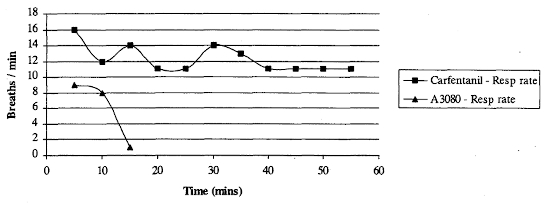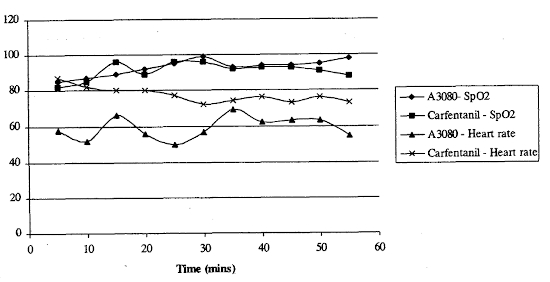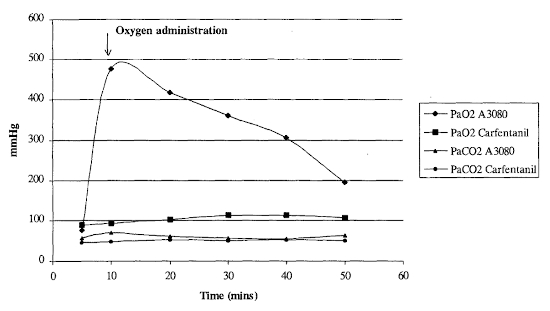Abstract
Giant eland (Taurotragus derbianus) is a problematic species to anesthetize because they are very large and prone to hyperthermia, capture myopathy, tympany, and fatal aspiration pneumonia resulting from regurgitation. Two anesthetic drug combinations were compared at White Oak Conservation Center, Yulee, FL USA in order to improve current anesthesia techniques. Anesthesia using a combination of A3080-medetomidine-ketamine (reversal with naltrexone and atipamezole) was compared to a combination of carfentanil-xylazine (reversal with naltrexone and yohimbine). The carfentanil combination is superior to the A3080 combination because it causes less respiratory depression. Regurgitation can occur using either combination, so endotracheal intubation is highly recommended.
Introduction
There are two species of eland, the common eland (Taurotragus oryx) and the giant eland (Taurotragus derbianus) and they are the largest of the antelope species (an adult bull can weigh up to 910 kg12). The two species are very different in their responses to anesthetic drugs (S. Citino, personal communication). Anesthesia of common eland has been reported in the literature, but no reports for giant eland were found.2-5,9,12 Giant eland are a problematic species to safely anesthetize because they are very large, have a tendency to run after being darted (which can lead to problems associated with hyperthermia and exertional myopathy if the induction period is prolonged) and are prone to tympany and regurgitation (leading to fatal aspiration pneumonia). An anesthetic protocol that results in a rapid and smooth induction with little excitation would be ideal as it would reduce the risk of hyperthermia and capture myopathy. In addition, drugs that lessen the likelihood of regurgitation would be of benefit.
A3080 is a synthesized fentanyl derivative with rapid, pronounced opiate agonist activity and it has a much shorter duration of action with only slightly less potency than carfentanil.7,9,10 It has been used with success in elk, moose, roan antelope, impala, buffalo, kudu, elephant, waterbuck, and common eland.1,6-8,10,11 In one study, induction times in elk using A3080 were significantly more rapid than with carfentanil and therefore A3080 may be beneficial in reducing hyperthermia and exertional myopathy.8 Another study showed no difference in induction times between A3080 and carfentanil in impala when similar mg/kg dosages were used, but also found induction times with A3080 were dose dependent.6,7 Like other opioids, A3080 provides little muscle relaxation and is typically used in combination with drugs that provide muscle relaxation (e.g., alpha2-agonists).
Methods
Five procedures using a combination of A3080-medetomidine-ketamine (reversal with naltrexone and atipamezole) were compared to 13 procedures using carfentanil-xylazine (reversal with naltrexone and yohimbine) (Table 1). All animals were clinically healthy and were being anesthetized for either electroejaculation, transportation, horn trimming, or hoof trimming. The females weighed 300–350 kg and the males weighed 400–500 kg.
Table 1. Immobilization regimes and their effects in eastern giant eland (Taurotragus derbianus)
|
Anesthesia agents
|
Time to first effect (sec)
|
Time to recumbency (min)
|
Reversal agents
|
Time of reversal (min)
|
n
|
|
A3080a=14.4±1.9 g/kg
Mc=8.6±3.1 g/kg
Ke=0.86±0.13 mg/kg
|
72±27
|
6.9±2.7
|
Nb=430±60 g/kg
Atid=38.9±11.7 g/kg
|
2.0±0.8
|
5
|
|
Cf=5.8±0.9 g/kg
Xg=70.7±22.3 g/kg
|
138±57
|
8.3±4.0
|
N=592±100 g/kg
Yh=103±20 g/kg
|
2.7±1.2
|
13
|
|
A3080=12.5 g/kg
M=1.9 g/kg
Azai=0.38 mg/kg
K=0.91 mg/kg
|
60
|
3
|
N=379 g/kg
Ati=7.6 g/kg
|
2
|
1
|
|
A3080=15.7 g/kg
Aza=0.52 mg/kg
K=0.84 mg/kg
|
120
|
4
|
N=472 g/kg
|
2
|
1
|
aA3080 (10 mg/ml, Wildlife Laboratories Inc., Fort Collins, CO 80524 USA).
bNaltrexone hydrochloride (50 mg/ml, Trexonil, Wildlife Laboratories Inc.).
cMedetomidine (20 mg/ml, Wildlife Laboratories Inc.).
dAtipamezole hydrochloride (5 mg/ml, Antisedan, Pfizer Animal Health, Exton, PA 19341 USA).
eKetamine (200 mg/ml, Creative Compounds, Wilsonville, OR 97070 USA).
fCarfentanil citrate (3 mg/ml, Wildlife Laboratories, Inc.).
gXylazine (20 mg/ml, Xylazine-20, Butler, Columbus, OH 43228 USA).
hYohimbine hydrochloride (5 mg/ml, Antagonil, Wildlife Laboratories Inc.).
iAzaperone (100 mg/ml, Kyron Laboratories Pty. Ltd., Benrose 2094, South Africa).
Times to first effect and recumbency, total anesthesia time, time of reversal, depth of anesthesia, environmental temperature, humidity, and body weight were recorded for each anesthesia. Every 5 min, heart rate, respiratory rate, body temperature, direct blood pressure (A3080 immobilizations only), and SpO2 were recorded. Within 5 min of induction and at every 10 min, an arterial blood sample was collected from the auricular artery and analyzed for pH, PaCO2, PaO2, HCO3-, TCO2, base excess, and SaO2. If possible two blood gas analyses were performed prior to oxygen supplementation by insufflation (10 l/min) or by positive pressure ventilation using a high flow demand valve (160 l/min). Serum creatine kinase and plasma lactate levels were measured following induction and immediately before reversal.
In all cases using A3080 and four of 13 cases using carfentanil, intubation was performed to protect the airway against regurgitation and aspiration (endotracheal tube sizes 16–24 mm).
Results and Discussion
Dosages of drugs used are summarized in Table 1. Mean heart rate, respiratory rate, SpO2, PaO2, and PaCO2 trends for the two anesthetic protocols are shown in Figures 1–3.
Induction was rapid with both anesthetic protocols and induction times were not significantly different. A3080 did not result in faster induction in this study, but this may have resulted from the use of a lower A3080 dose than the carfentanil dose used. With both protocols, some animals dove headfirst into the ground during induction. In two cases using the A3080 combination, mild regurgitation occurred during induction. This also occurred in one case using the carfentanil combination. Moderate to severe regurgitation occurred during anesthesia in all A3080 cases, though all these cases were held in lateral recumbency for electroejaculation. It was thought that the alpha2-agonist, medetomidine, may have been contributing to the regurgitation, because previous experience with xylazine has shown that when used as the sole agent for sedation in giant eland, it can result in heavy sedation with regurgitation. Regurgitation also occurred in four of the 13 carfentanil immobilizations.
Figure 1

Mean respiratory rate for A3080-medetomidine-ketamine and carfentanil-xylazine anesthesia in eastern giant eland (Taurotragus derbianus gigas).
Figure 2

Mean heart rate and SpO2 values for A3080-medetomidine-ketamine and carfentanil-xylazine anesthesia in eastern giant eland (Taurotragus derbianus gigas).
Figure 3

Mean PaO2 and PaCO2 values for A3080-medetomidine-ketamine and carfentanil-xylazine anesthesia in eastern giant eland (Taurotragus derbianus gigas).
Respiration was severely depressed by the A3080 combination (Figure 1) with all animals requiring intermittent positive pressure ventilation (IPPV) through an endotracheal tube using 100% oxygen and a high flow demand valve. Animals anesthetized using the carfentanil combination maintained respiration and were only supplemented with oxygen by insufflation through an endotracheal tube or intranasally. SpO2 values correlated well with SaO2 values. SpO2 were initially only fair (range 82–87) with both combinations but improved (range 92–99) and were maintained with oxygen supplement (Figure 2), but in the case of the A3080 immobilizations were probably only maintained due to the IPPV. PaO2 and PaCO2 trends (Figure 3) for the A3080 and carfentanil anesthesias cannot be compared because giant eland given A3080 required IPPV with 100% oxygen, while the carfentanil-xylazine anesthetized eland maintained active respiration throughout and were only supplied oxygen via nasal or endotracheal tube insufflation.
Mean heart rates were lower with the A3080 combination than with the carfentanil combination (Figure 1). This may have resulted from a reflex response to the peripheral vasoconstriction and increased blood pressure caused by the medetomidine in combination with the A3080. Moderate hypertension was seen initially in the A3080 anesthetized eland, but within 50 minutes all animals were normotensive, suggesting that the A3080-medetomidine combination may have also had a direct effect on lowering heart rate. Temperatures maintained in the range of 37.5–39.5°C with both immobilization combinations and probably reflected the rapid inductions with minimal pacing/running times. CK and lactate levels were within acceptable limits. Recovery following reversal was smooth with both combinations and times to standing were similar.
Carfentanil-xylazine is superior to A3080-medetomidine-ketamine in giant eland because it causes less respiratory depression. Regurgitation can occur with both anesthetic combinations, so it is highly recommended to intubate giant eland in order to protect the airway as soon as possible following induction. Further investigation of alternative drug combinations is required to try to eliminate the problem of regurgitation.
One case of A3080-low dose medetomidine-azaperone-ketamine anesthesia and one case of A3080-azaperone-ketamine anesthesia (Table 1) were performed to see if reducing or removing the alpha2-agonist dose from the anesthetic combination would reduce the incidence of regurgitation. Both cases regurgitated.
Acknowledgments
The authors would like to thank the keepers and veterinary technicians at White Oak Conservation Center for their help in this study. This study was supported through funding by the Howard Gilman Foundation.
Literature Cited
1. Citino, S.B., M. Bush, D. Grobler, and W. Lance. 2001. Anaesthesia or roan antelope (Hippotragus equinus) with a combination of A3080, medetomidine, and ketamine. J. South African Vet. Assoc. 72(1).
2. Drevemo, S. and L. Karstad. 1974. The effect of xylazine and xylazine-etorphine-acepromazine combination on some clinical and haematological parameters in impala and eland. J. Wildl. Dis. 10: 377–383.
3. Ganhao, M., J. Hattingh, N. Pitts, C. Raath, B. de Klerk, and V. de Vos. 1988. Physiological responses of blesbok, eland, and red hartebeest to different capture methods. South African J. Wildl. Res. 18: 134–136.
4. Grootenhuis, J.G., L. Karstad, and S.A. Drevemo. 1976. Experience with drugs for capture and restraint of wildebeest, impala, eland and hartebeest in Kenya. J. Wildl. Dis. 12: 435–443.
5. Harthoorn, A.M. 1972. Restraint and neuroleptanalgesia in ungulates. Vet. Rec. 91: 63–66.
6. Janssen, D.L., J.L. Allen, J.P. Raath, V. de Vos, G.E. Swan, D. Jessup, and T.H. Stanley. 1991. Field studies with the narcotic immobilizing agent A3080. Proc. Amer. Assoc. Zoo Veterinarians. Pp. 340–342.
7. Janssen D.L., G.E. Swan, J.P. Raath, S.W. McJames, J.L. Allen, V. de Vos, K.E. Williams, J.E. Anderson, and T.H. Stanley. 1993. Immobilization and physiologic effects of the narcotic A-3080 in impala (Aepyceros melampus). J. Zoo Wildl. Med. 24:11–18.
8. McJames, S.W., I.L. Smith, T.H. Stanley, and G. Painter. 1993. Elk immobilization with potent opioids: A-3080 vs. carfentanil. Proc. Amer. Assoc. Zoo Veterinarians. Pp. 418–419.
9. McKenzie, A.A. (ed) 1993. The capture and care manual. Wildlife Decision Support Services CC, Lynnwood Ridge, South Africa.
10. Stanley, T.H., S. McJames, and J. Kimball. 1989. Chemical immobilization for the capture and transportation of big game. Proc. Amer. Assoc. Zoo Veterinarians. Pp. 13–14.
11. Stanley, T.H., S. McJames, and J. Kimball. 1988. Immobilization of elk with A-3080. J. Wildl. Management 52:577–581.
12. Young, E. 1992. Game Farming and Wildlife Management. Eddie Young Publishers, Nylstroom, South Africa. Pp. 27–28, 80.